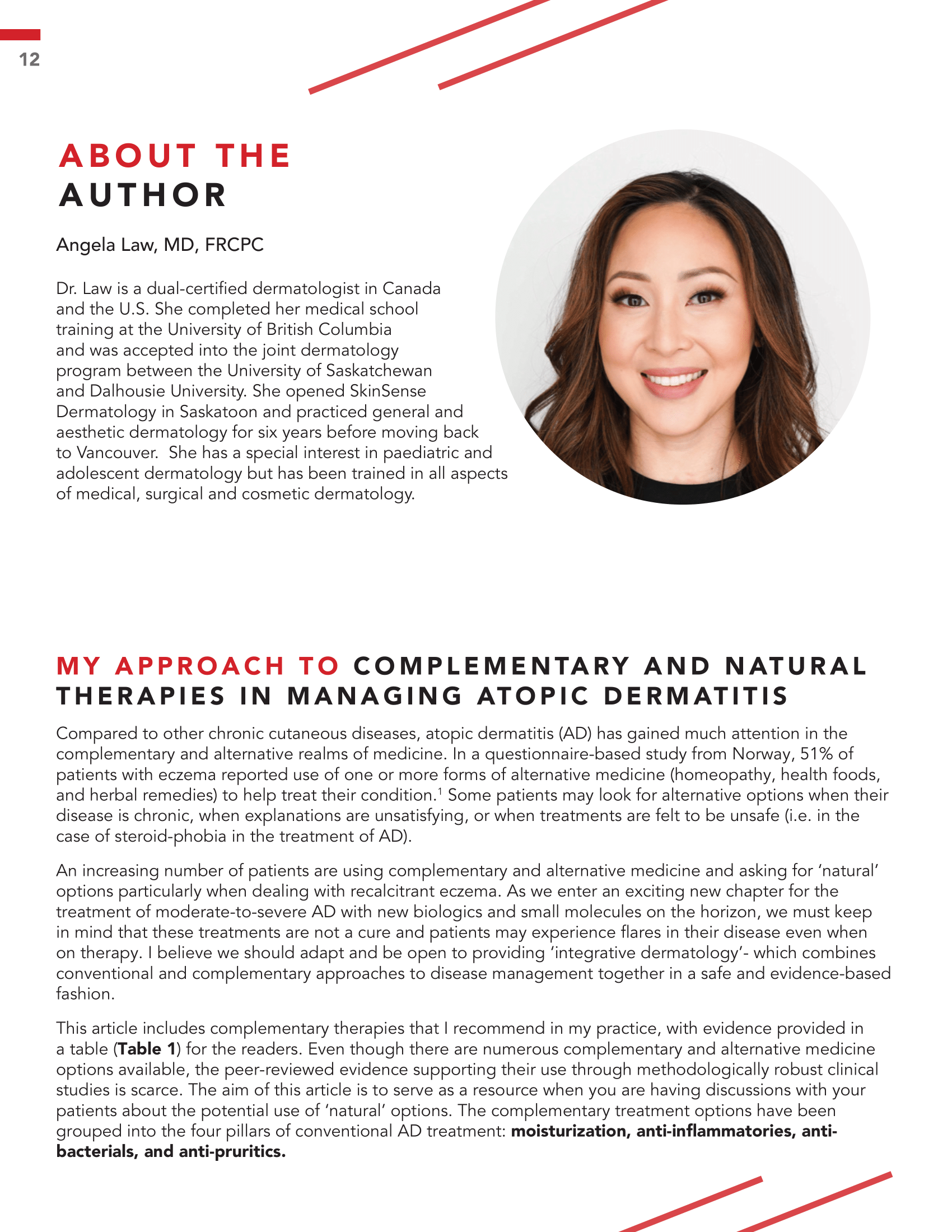My Approach To Complementary and Natural Therapies In Managing Atopic Dermatitis
Abstract
Compared to other chronic cutaneous diseases, atopic dermatitis (AD) has gained much attention in the complementary and alternative realms of medicine. In a questionnaire-based study from Norway, 51% of patients with eczema reported use of one or more forms of alternative medicine (homeopathy, health foods, and herbal remedies) to help treat their condition. Some patients may look for alternative options when their disease is chronic, when explanations are unsatisfying, or when treatments are felt to be unsafe (i.e. in the case of steroid-phobia in the treatment of AD).
An increasing number of patients are using complementary and alternative medicine and asking for ‘natural’ options particularly when dealing with recalcitrant eczema. As we enter an exciting new chapter for the treatment of moderate-to-severe AD with new biologics and small molecules on the horizon, we must keep in mind that these treatments are not a cure and patients may experience flares in their disease even when on therapy. I believe we should adapt and be open to providing ‘integrative dermatology’- which combines conventional and complementary approaches to disease management together in a safe and evidence-based fashion.
References
Jensen P. Use of alternative medicine by patients with atopic dermatitis and psoriasis. Acta Derm Venereol. 1990;70(5):421-4.
Ma H, Shi V, Lio Peter. Multidisciplinary toolbox for atopic dermatitis treatments. Prac Dermatol. 2021 Feb;25-34.
Eichenfield LF, McCollum A, Msika P. The benefits of sunflower oleodistillate (SOD) in pediatric dermatology. Pediatric Dermatology. 2009; 26(6):669–675.
Danby SG, AlEnezi T, Sultan A, et al. Effect of olive and sunflower seed oil on the adult skin barrier: implications for neonatal skin care. Pediatr Dermatol. 2013 Jan-Feb;30(1):42-50.
Intahphuak S, Khonsung P, Panthong A. Anti-inflammatory, analgesic, and antipyretic activities of virgin coconut oil. 2010. Pharmaceutical Biology. 48(2):151–157.
Verallo-Rowell VM, Dillague KM, Syah Tjundawan BS. Novel antibacterial and emollient effects of coconut and virgin olive oils in adult atopic dermatitis. 2008. Dermatitis: Contact, Atopic, Occupational, Drug. 19(6):308–315.
Evangelista MT, Abad Casintahan F, Lopez Villafuerte L. The effect of topical virgin coconut oil on SCORAD index, transepidermal water loss, and skin capacitance in mild to moderate pediatric atopic dermatitis: a randomized, double-blind, clinical trial. Int J Dermatol. 2014 Jan;53(1):100-8.
Lee JH, Lee SJ, Kim DS, Bang D. The effect of wet-wrap dressing on epidermal barrier in patients with atopic dermatitis. 2007. Journal of the European Academy of Dermatology and Venereology. 21(10):1360–1368.
Devillers A, Oranje A. Wet-wrap treatment in children with atopic dermatitis: A practical guideline. 2021. Ped Dermatol. 29(1): 24-27.
Devillers ACA, Oranje AP. Efficacy and safety of ‘wet-wrap’ dressings as an intervention treatment in children with severe and/or refractory atopic dermatitis: a critical review of the literature. 2006. The British Journal of Dermatology. 154(4):579–585.
Slyshenkov VS, Dymkowska D, Wojtczak L. Pantothenic acid and pantothenol increase biosynthesis of glutathione by boosting cell energetics. 2004. FEBS Lett. 569:169-172.
Udompataikul M, Limpaovart D. Comparative trial of 5% dexpanthenol in water-in-oil formulation with 1% hydro-cortisone ointment in the treatment of childhood atopic dermatitis: a pilot study. 2012. J Drugs Dermatol. 11:366–374.
Januchowski et al. Evaluation of topical vitamin B12 for treatment of childhood eczema. 2009. J of Alternative and complementary medicine. 15(4):387-389.
Stucker M et al. Topical vitamin B12- a new therapeutic approach in atopic dermatitis- evaluation of efficacy and tolerability in a randomized placebo-controlled multicenter clinical trial. 2004. Br J Dermatol. 150:977-983.
Huang JT, Abrams M, Tlougan B, Rademaker A, Paller AS. Treatment of Staphylococcus aureus colonization in atopic dermatitis decreases disease severity. 2009. Pediatrics. 123(5):e808–e814.
Chopra R, Vakharia P, Sacotte R, Silverberg J. Efficacy of bleach baths in reducing severity of atopic dermatitis: A systematic review and meta-analysis. Ann Allergy Asthma Immunol. 2017;119:435-40.
Lee M, Bever HV. The role of antiseptic agents in atopic dermatitis. 2014. Asia Pac Allergy. 4:230-240.
Fabric selection in atopic dermatitis: An Evidence-Based Review. Am J Clin Dermatol. 2020 Aug. 21[4]:467-482.
Lopes C, Silva D, Delgado L, Correia O, Moreira A. Functional textiles for atopic dermatitis: a systematic review and meta-analysis. 2013. Pediatric Allergy and Immunology. 24(6):603–613.
Bircher AJ. Aquagenic pruritus: treatment with sodium bicarbonate and evidence for a seasonal form. J Am Acad Dermatol. 1989;21:817. doi: 10.1016/S0190-9622(89)80295-6.
Wolf R, Krakowski A. Variations in aquagenic pruritus and treatment alternatives. J Am Acad Dermatol. 1988;18:1081–1083.
Rajatanavin N, Withers A, Bernhard D. Baking soda and pruritus. Lancet. 1987;2(85650):977.
Cerio E, Dohil M, Jeanine D, Magina S, Mahe E, Stratigos A. Mechanism of action and clinic benefits of colloids oatmeal for dermatologic practice. 2010. J Drugs Dermatol. 9(9):1116-20.
Fowler J. Colloidal oatmeal formulations and the treatment of atopic dermatitis. 2014. J Drugs Dermatol. 13(10):1180-3.
Sompayrac LM, Ross C. Colloidal oatmeal in atopic dermatitis of the young. J Fla Med Assoc. 1959;45(12):1411-1412.
Wolf R, Krakowskii A. Variations in aquagenic pruritus and treatment alternatives. 1988. JAAD;18(5):1081-1083.
Eichenfield L, Ahluwalia J, Waldman A, Borok J, Udkoff J, Bogunieewicz M. Current guidelines for the evaluation and management of atopic dermatitis: A comparison of the Joint Task Force Practice Parameter and American Academy of Dermatology guidelines. 2017. J Allergy Clin Immunol.139(4):S49-S57.


